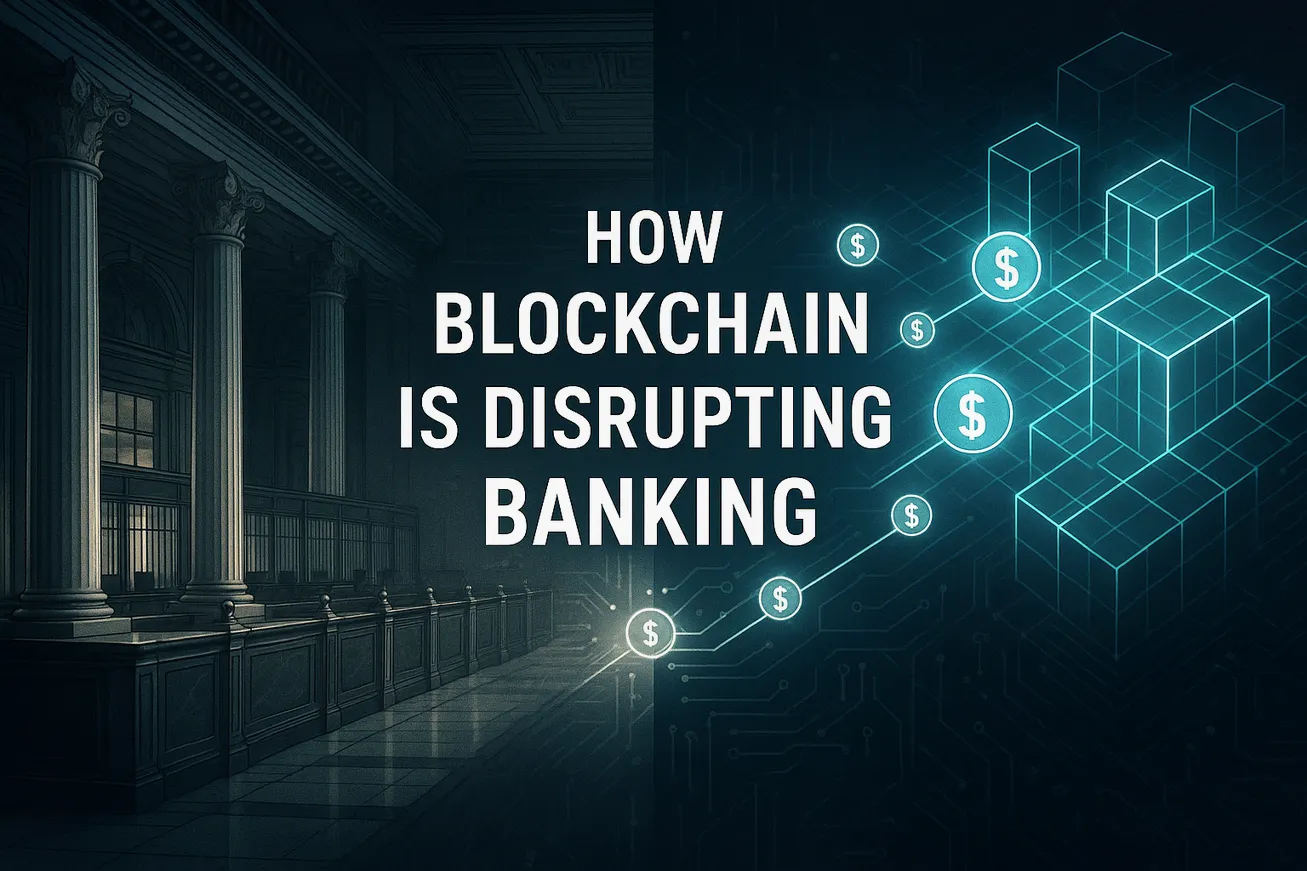Banking is in the middle of its biggest rethink in decades. The debate used to be whether crypto was a fad. Today, the question is much more practical: how do we use blockchain to make banking faster, cheaper, safer, and programmable. If you want to understand the shift, this is your field guide to what’s actually changing, what’s hype, and where the opportunities really are.
Focus keyword: How Blockchain Is Disrupting Banking
Snapshot of the disruption
Blockchain is disrupting banking by:
- Compressing settlement times from days to near-instant finality
- Lowering fees in cross-border payments and remittances
- Making money programmable with smart contracts
- Enabling 24/7/365 markets and atomic delivery-versus-payment
- Improving auditability and transparency for compliance
- Unlocking tokenization of deposits, treasuries, funds, and private assets
This isn’t a hypothetical future. Banks, central banks, and global market infrastructures are piloting or running production systems today. Stablecoins, CBDC experiments, tokenized deposits, and permissioned ledgers are all converging on the same outcome: a digital money stack that looks and feels like the internet.
Why this matters now
- Consumer expectations: Instant money movement has become table stakes.
- Cost pressure: Cross-border payments still average notable fees in many corridors; on-chain rails can compress costs.
- Regulation is catching up: MiCA in the EU, evolving stablecoin rules in multiple jurisdictions, and institutional-grade custody frameworks are clarifying what’s allowed.
- Capital efficiency: Intraday liquidity, programmable settlement, and collateral mobility can materially reduce operational and capital costs.
The core pillars where blockchain is reshaping banking
1) Payments and remittances
- Cross-border transfers move from multi-hop correspondent networks to shared ledgers with finality in seconds or minutes.
- Stablecoins and tokenized deposits enable always-on settlement with predictable fees.
- Interoperability with ISO 20022 messaging unifies core banking workflows with on-chain transactions.
What changes for customers: Faster payroll, instant merchant settlement, cheaper remittances, and fewer failed or delayed transfers.
2) Treasury, liquidity, and settlement
- Tokenized cash and collateral allow intraday liquidity management with precision.
- Smart contracts can enforce delivery-versus-payment (DvP) or payment-versus-payment (PvP), reducing counterparty and settlement risk.
- Real-time gross settlement on permissioned chains helps treasurers move cash and collateral across desks and entities in minutes.
3) Capital markets and tokenization
- Bonds, funds, commercial paper, and private assets can be issued as tokens, reducing issuance and servicing friction.
- Programmable corporate actions (coupons, dividends) reduce manual reconciliations.
- Secondary liquidity on 24/7 venues can unlock price discovery for traditionally illiquid assets.
4) Trade finance and supply chains
- Letters of credit and invoices become on-chain objects with embedded rules.
- Document fraud decreases via shared truth, and settlement ties directly to shipment events via oracles.
5) Identity, KYC/AML, and compliance
- Reusable digital identity credentials can satisfy KYC once and be selectively disclosed with zero-knowledge proofs.
- On-chain analytics augment AML monitoring by tracing fund flows programmatically.
- Policy controls: Addresses and assets can be whitelisted, blacklisted, or subject to rules at the token level.
6) Lending, deposits, and programmable money
- Smart contracts automate origination, servicing, and liquidation logic.
- Tokenized deposits and bank-issued stablecoins bring bank-grade money on-chain.
- Interest accrues programmatically, and covenants can be monitored in real time.
Public vs permissioned chains
- Public blockchains: Open access, high composability, global liquidity, rapid innovation. Useful for stablecoins, global settlement, and open finance.
- Permissioned blockchains: Controlled participation, enterprise-grade privacy, and role-based governance. Useful for interbank settlement, trade finance, and tokenized deposits.
Most banks will operate a hybrid model: interact with public rails for reach and liquidity, while running permissioned networks for regulated workflows.
Stablecoins, CBDCs, and tokenized deposits
- Stablecoins: Fiat-referenced tokens issued by private entities, widely used for global settlement and 24/7 commerce. They already underpin massive payment volumes.
- CBDCs: Central bank digital currencies providing sovereign settlement assets on digital rails. Pilots target cross-border corridors and wholesale settlement.
- Tokenized deposits: Bank liabilities represented as tokens. They combine deposit protection with on-chain programmability and bank-grade compliance.
Expect coexistence. Each instrument serves a distinct purpose across retail payments, wholesale settlement, and cross-border liquidity.
Proven use cases that are shipping
- Interbank settlement and intraday repo on permissioned chains with near-instant settlement.
- Tokenized money market funds offering same-day or instant share transfers and programmable redemptions.
- Cross-border stablecoin payments for payroll and B2B transactions with sub-hour finality.
- On-chain bond issuance where cash leg and securities leg settle atomically, reducing fails and collateral drag.
- Programmable escrow in trade finance where shipment events unlock partial payments automatically.
These aren’t pilots for PR. They’re beginning to move real value, with fintechs and banks integrating custody, compliance, and tokenization modules into core systems.
Architecture patterns that actually work
- Custody and key management: HSMs, MPC wallets, and policy engines for enterprise-grade approvals.
- Token standards: ERC-20/6960 for fungibles, ERC-1400 for securities, and compliance-aware token frameworks.
- Oracles: Event-driven payments (e.g., a shipment scanned, a price threshold hit) with verified data feeds.
- Interop: Bridges and messaging layers aligned to ISO 20022 to tie core banking to on-chain flows.
- Privacy: Selective disclosure, account abstraction, and zero-knowledge KYC for confidentiality without sacrificing compliance.
Compliance isn’t optional, it’s programmable
- Travel Rule and sanctions screening can sit in pre-transaction checks.
- Risk tiers by asset type and address cluster scores inform policy-based approvals.
- Auditors can view cryptographic proofs of controls, access, and lifecycle events.
Regulation is still evolving by jurisdiction, but the trajectory favors well-controlled, transparent, and auditable systems.
The real friction points to plan for
- Fragmentation: Multiple chains, standards, and liquidity pools create operational complexity.
- Key risk: Private key compromise remains one of the largest risk vectors; use MPC and hardware-backed governance.
- Data privacy vs transparency: Calibrate what is public, private, or permissioned.
- Operational readiness: 24/7 rails require 24/7 risk, liquidity, and support processes.
- Vendor lock-in: Favor open standards and exit strategies.
A strategic playbook for banks
1) Start with payments and liquidity
– Stand up always-on settlement for internal transfers and corporate treasuries.
– Pilot tokenized deposits and enable whitelisted client wallets.
2) Tokenize cash-like assets first
– Funds, T-bills, and commercial paper have straightforward cash flows and demand.
3) Build compliance from day zero
– Integrate KYC, on-chain analytics, and Travel Rule modules; establish risk-based policies for wallets and assets.
4) Interoperate with core systems
– Align with ISO 20022; ensure accounting, reconciliation, and reporting capture token events.
5) Measure what matters
– Time-to-settle, fail rates, cost-per-transaction, liquidity savings, and capital efficiency.
What this means for corporates and fintechs
- Treasurers can sweep cash into tokenized funds with intraday liquidity and programmable rules.
- Marketplaces can settle globally with stablecoins, reducing chargeback and FX friction.
- Lenders can encode covenants and automate interest, margin, and collateral processes.
- Auditors and controllers get real-time, immutable ledgers of transactions and positions.
For individuals exploring on-chain finance
Stablecoins, tokenized assets, and decentralized markets are increasingly accessible through regulated platforms. If you’re curious about on-chain markets, education and responsible access matter.
- Explore reputable platforms, understand fees and risks, and enable 2FA with hardware-backed security where possible.
- Diversify custody: consider a mix of exchange custody, institutional-grade wallets, and, for advanced users, self-custody with clear recovery procedures.
Exclusive offer for readers:
- Create an account at MEXC and explore on-chain assets, stablecoins, and spot or futures markets using our partner link. Use referral code mexc-CRYPTONEWER for promotional benefits when signing up on MEXC.
Note: Digital assets are volatile and may not be suitable for all investors. Only risk what you can afford to lose, and consider speaking with a qualified advisor.
Deep dive on cost and speed
- Cross-border payments: Traditional corridors can involve multiple correspondent banks with cumulative fees and variable FX spreads. On-chain rails collapse intermediaries and settle in minutes, often at predictable network fees.
- Settlement cycles: Tokenized securities with atomic DvP can move from T+2 to T+0, cutting settlement fails and collateral needs.
- Treasury operations: Intraday sweeps and programmable settlement reduce trapped cash and reconciliation cycles.
Interoperability is the quiet unlock
The future is multi-chain. Banks will operate across public and private networks, relying on:
- Messaging standards to orchestrate off-chain instructions with on-chain settlement
- Compliance-aware bridges to maintain policy enforcement across networks
- Indexing and data layers to unify positions, PnL, and risk across ledgers
Technology choices without the buzzwords
- Rollups and Layer 2: For public chains, rollups provide low-cost, high-throughput lanes while settling to a secure base chain.
- Zero-knowledge proofs: Selectively reveal what’s necessary—prove KYC or solvency without exposing raw data.
- Account abstraction: Improves UX, enabling policy-based wallets, session keys, spend limits, and social recovery.
What success looks like
- Clients move money globally in minutes with compliance controls embedded in the transaction.
- Securities issuance and settlement are programmable and auditable end-to-end.
- Treasury teams operate on real-time rails, optimizing liquidity intraday.
- Regulators get better transparency with less manual reporting.
If you’re building or buying in this space, prioritize production-grade controls, interoperability, and a phased rollout aligned to clear ROI metrics.
Resources and next steps
- Standards and compliance: Track guidance on stablecoins, digital asset custody, and Travel Rule implementations in your jurisdiction.
- Vendor checklist: Ask about MPC, key recovery, policy engines, segregation of duties, and SOC2/ISO certifications.
- Hands-on learning: Open a sandbox, test stablecoin rails for B2B payments, and evaluate tokenization of internal cash equivalents.
- Community and markets: Learn by participating responsibly in regulated venues. Claim a welcome benefit at MEXC with referral mexc-CRYPTONEWER and explore educational materials, spot and derivatives markets, and on-chain integrations.
FAQ on How Blockchain Is Disrupting Banking
-
Is this just about crypto prices?
No. The disruption is about programmable settlement, 24/7 markets, and verifiable records—not speculation. -
Will banks be replaced?
Unlikely. Banks that adapt will become orchestrators of programmable finance, combining trust, compliance, and new rails. -
Public or private blockchains?
Both. Use the right tool for the job, often connected via compliance-aware interop. -
What about data privacy?
Private or permissioned chains, selective disclosure, and zero-knowledge proofs enable confidentiality with compliance. -
How do we get started?
Begin with internal settlement or corporate treasury pilots, add tokenized cash-like instruments, and expand to capital markets use cases as controls mature.





